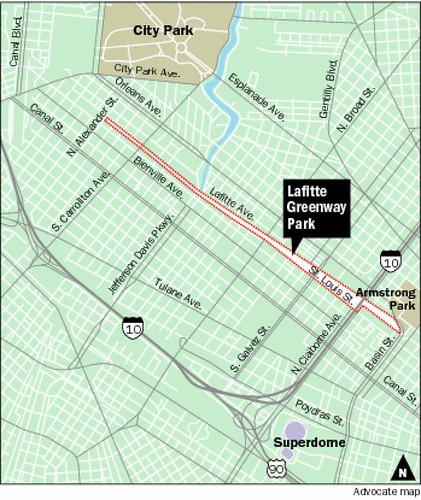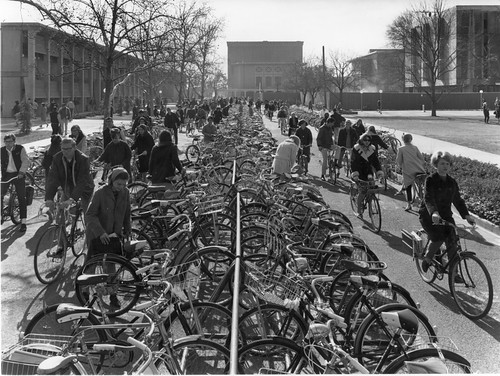Bicycling roundup
Tandem bicyclists (the bike is also outfitted with a baby carrier) at 7th Street and Massachusetts Avenue NW, Washington, DC.
1. Sacramento is consider banning biking on sidewalks, at least in the core ("Sacramento ponders: Where should sidewalk cycling be banned?," Sacramento Bee).
2. Denver's bike share reliant on bike balancing to keep the system moving, loses about $300,000/year ("Success of nonprofit B-Cycle system hinges on non-stop bike shuffling," Denver Post).
3. Research says that bike share in DC reduces congestion by 2% to 3% ("Study: Bike share has (slightly) reduced congestion in Washington, DC," Vox).
But I wonder if the neighborhoods where stations are located are proxies for the benefits of density and the efficiency of sustainable mobility more generally-- my sense in the core especially is that bike share trips aren't substituting for motor vehicle trips.
4. London has switched sponsors of the bike share program there, from Barclays Bank (blue bikes) to Santander Bank (red bikes). There is a tender out for new bikes, although that seems like a waste of energy to me.
There are some interesting promotional activities for London's bike share program, guided bike tours and use of the share bikes for spin classes as part of the Thames Riverfest ("Santander Cycles creates one-of-a-kind cycling events for London," BikeHub).
 The trail is open to walkers, runners and cyclists. Photo: Matthew Gilson for the Wall Street Journal.
The trail is open to walkers, runners and cyclists. Photo: Matthew Gilson for the Wall Street Journal.5. Wall Street Journal features the new shared use trail in the Bloomingdale neighborhood of Chicago ("A Tour of Chicago's Bloomingdale Trail"). The trail was built on a no longer used elevated rail viaduct.
A couple weeks earlier there was a piece on the trail in Greater Greater Washington ("The Metropolitan Branch Trail could learn a thing or two from Chicago's bike trail") which suggested by way of comparison that DC should incorporate more amenities into its budding system of trails.
People without homes appear to have set up tents along the railyard and the Metropolitan Branch Trail in the NoMA district.
I agree, but part of the problem has been minimal use and the fact that trails can be underutilized so that street furniture and other amenities may be mis-used and vandalized. What that made me realize is that public space planning needs to create phased plans and put aside money for the addition of amenities over time as use conditions become more favorable to their placement.

6. There is a similar intra-city trail being developed in New Orleans called the Lafitte Greenway, which was written up in the New Orleans Advocate ("Locals enjoy Lafitte Greenway ahead of park's official opening").
An advantage of in-city trails is that they provide a route free of car traffic--even if you may still have to deal with walkers, dogs, and criminal attacks and assaults (but hey, it's a city). It's not until you ride on a trail that you realize how much mental energy is spent by cyclists on defensive cycling while "sharing the road."
7. Another good story on trails was in the Arizona Republic ("Piece by piece, web of Valley bike paths taking shape").
Compared to Phoenix, the DC metropolitan area seems to be behind at least in "marketing" an integrated network of trails.
When I was there in 2009, I was surprised to see that the Maricopa County Association of Governments publishes an integrated bike trail map, showing all the trails of each jurisdiction on one map--we don't have an equivalent map, say published by the Metropolitan Washington County of Governments, in the DC area.
Metropolitan Washington has a number of regionally-serving bikeways, but they aren't promoted well, and there are many significant gaps in the network.
8. The Arizona Republic also ran a piece on mountain bike parks in Greater Phoenix ("Arizona bike parks: thrills on two wheels"). And a new pump track opened in Central Pennsylvania ("Down and dirty: New BMX pump track in Philipsburg delivers another option for fun," Centre Daily Times).
9. While such facilities are more about recreation than transportation, I do think that traditional biking (as transportation plans) should include mountain bike accommodations and bike tourism.
I did notice that a lot of "ski resort" communities out west aim to maintain tourism in the summer by promoting trail use and biking, among other activities.
Anyway, the Bike Tour Network is an organization focusing on organized bike tours and events, while I am also thinking of more organic tourism also using bike as a way to get around as part of "City Break" tourism. The organization's annual conference is this November.
Ontario's Niagara Falls area has a particularly good bike tourism website, Niagara Cycling Tourism Centre.
10. Carlton Reid, a British journalist and proponent of cycling is working on a book called Bike Boom: The Unexpected Boom in Cycling, 1970 - 2000.
11. It might end up being a UK-version of Pedaling Revolution, given Reid's recent piece in the Guardian on the success of biking as transportation in Davis, California, where about 20% of daily trips are made by bike, highest in the US. Davis features heavily in Pedaling Revolution.

Amsterdam or the US? Bike racks at the University of California, Davis, 1963. Photograph by Ansel Adams.
12. According to the Guardian ("An Uber for bicycles? The grand ambitions of Danish startup AirDonkey") there is a new bike access scheme set up somewhat like Airbnb.
They offer bike owners a kit that outfits the bike for shared use, with a lock that is accessed by a mobile phone application and is battery operated.
AirDonkey shares the revenues with the bike owner.
While the AirDonkey principals think this will "disrupt" transportation as we know it, it's not likely that will happen.
That's because it's destined for a relatively small scale of operations--there aren't lots of people out there willing to put their bikes in such schemes (although it'd be a way to get some use out of the bike I bought for Suzanne that she doesn't use) or up for renting bikes in this way, although for both elements there is some latent market demand that heretofore hasn't been able to be met because of difficulty in creating systems that would enable it.
13. Vision studies produced by the UK Government's Foresight Project initiative on the Future of Cities promote cycling in a big way. See Future of Cities: Beyond Peak Car and Active travel in the city of the future. Individual city reports have been produced for Cambridge, Newcastle, and Lancaster and other cities, and are accessible through the project's Future of Cities blog.
14. Guardian Cities ongoing series of articles on biking around the world, Cycling the City, has many great articles. One that stands out is on Groningin, Netherlands. In the 1970s, they took radical steps to prioritize biking and walking in the city center over automobility.
Even today, what they did--creating four sub-districts and making it impossible to drive between the districts within the city, but only via a ring road, would be considered quite revolutionary. Now the city is considering moving bus service out to the ring road, to further walking, biking, placemaking, and noise reduction initiatives.
An artist’s impression of the Promenade, a cycle-friendly Christchurch redevelopment project.
Another piece on Christchurch, New Zealand discusses how post-earthquake, the city is refocusing on biking, especially in the city center, as the most sustainable means for faster mobility and quality of life.
The proposal for a sustainable mobility corridor called the Promenade looks quite exciting.
Labels: bicycle and pedestrian planning, transportation planning









5 Comments:
re: bike for Suzanne that she doesn't use... www.bikesfortheworld.org
-EE
never... I will not give up. Although I am thinking about a tandem.
Sacramento is going backwards- what a bunch of losers
On Friday, 10 automakers agreed to put the automatic braking systems into cars.
This is going to have a huge change in 20+ years.
Pavements matters as well. The M st bike lane is still mostly usable on parts thanks to terrible pavement and construction. The 15th and R st lanes are much easier to use. I know I am getting old but I was on the verge of giving up my daily bike ride to the west end based on the road conditions and bumps.
Again, specific to DC but bike infrastructure seems best when used in off-peak hours.
The stretch of 2nd St. NE between D St. and Constitution Ave. NE is worse than abominable. It's certainly an E on an A-E scale. (On 2nd St. between East Capitol and Pennsylvania Ave. SE, recently DDOT restriped the road--road diet--to add an on-street bike line in both directions.)
Meanwhile, my alley, probably a C, but still with many years of useful life (although the people on the south side of the alley didn't like the subsidence issue) got reconstructed.
I don't know how the city makes decisions on replacing C grade alleys in terms of the Pavement Condition Index (which is actually a 100 point scale) versus E grade streets.
The 15th St. cycletrack was equally bad vis a vis your M St. road when it was first striped. Really really bad, at least from P to U.
Post a Comment
<< Home